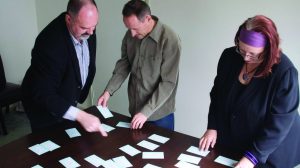When I talk about ‘getting physical’ I’m not talking about standing meetings, or energiser games (or 1980s aerobics complete with leg-warmers and sweat bands)! I’m talking about physical, tangible tools or artefacts, and here are 3 reasons why you should use them in your next meeting or workshop….
1. They provide a focus on something other than the participants

For many participants in a workshop or meeting, it can feel confronting to have the attention of a group, or even another individual, focused directly on them. So they may close down and elect not to participate actively. Having something else for the participants to look at, and to talk about, helps to divert that direct attention.
My friend Amanda was recently telling me about how she used a set of ‘strength cards’ to facilitate a discussion with a group of women with post-natal depression, and how the cards seemed to help them to open up as they picked them up, moved them around, and spoke about them.
In the design thinking crash course that I run, participants build physical prototypes and then receive feedback on those prototypes from a partner. Criticism of your ideas isn’t always easy to hear, but the presence of the physical prototype focuses the discussion on how it works and how it could be improved. Partners sit together and look at and touch the prototype and talk about it. It helps the participants to let go of their sense of ‘ownership’ of the idea and instead focus on the idea itself.
2. They engage other senses
Too many meetings and workshops are just about talking and listening, although in many meetings I’ve been in far more of the former tends to happen! But not everyone is best engaged through their auditory sense. What about all the people who best process information visually or kinaesthetically?
3. They help to reduce misunderstanding
Have you ever been in a workshop or discussion, especially ones that involve group work, where the group has a discussion, reaches a conclusion, goes to move onto the next part of the discussion or next step in the exercise, and one or more people look confused and say ‘I thought we were going to…’?
A physical representation of the group’s conclusion/decision can help to confirm understanding and provides something for the group to refer back to as the discussion progresses.
So, how can you use physical tools? One of the most simple ways is sticky notes of course! In your next meeting, instead of just discussing ideas, topics, issues, solutions, questions, why not try out having participants write them on a sticky note? You then have the ability to use them in a variety of ways to group, allocate, order and prioritise.
Leave a Reply